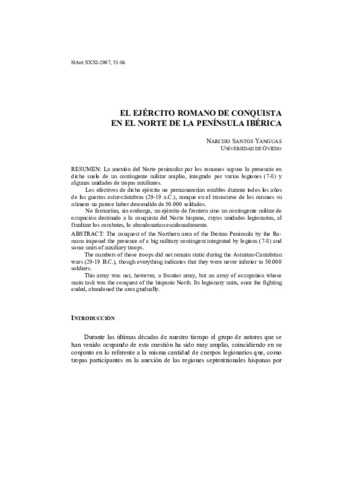El ejército romano de conquista en el norte de la Península Ibérica
Author:
Publication date:
Editorial:
Universidad de Valladolid: Departamento de Historia Antigua
Citación:
Descripción física:
Abstract:
La anexión del Norte peninsular por los romanos supuso la presencia en dicho suelo de un contingente militar amplio, integrado por varias legiones (7-8) y algunas unidades de tropas auxiliares. Los efectivos de dicho ejército no permanecerían estables durante todos los años de las guerras astur-cántabras (29-19 a.C.), aunque en el transcurso de los mismos su número no parece haber descendido de 50.000 soldados. No formarían, sin embargo, un ejército de frontera sino un contingente militar de ocupación destinado a la conquista del Norte hispano, cuyas unidades legionarias, al finalizar los combates, lo abandonarían escalonadamente.; The conquest of the Northern area of the Iberian Peninsula by the Romans imposed the presence of a big military contingent integrated by legions (7-8) and some units of auxiliary troops. The numbers of those troops did not remain static during the Asturian-Cantabrian wars (29-19 B.C.), though everything indicates that they were never inferior to 50.000 soldiers. This army was not, however, a frontier army, but an army of occupation whose main task was the conquest of the hispanic North. Its legionary units, once the fighting ended, abandoned the area gradually.
La anexión del Norte peninsular por los romanos supuso la presencia en dicho suelo de un contingente militar amplio, integrado por varias legiones (7-8) y algunas unidades de tropas auxiliares. Los efectivos de dicho ejército no permanecerían estables durante todos los años de las guerras astur-cántabras (29-19 a.C.), aunque en el transcurso de los mismos su número no parece haber descendido de 50.000 soldados. No formarían, sin embargo, un ejército de frontera sino un contingente militar de ocupación destinado a la conquista del Norte hispano, cuyas unidades legionarias, al finalizar los combates, lo abandonarían escalonadamente.; The conquest of the Northern area of the Iberian Peninsula by the Romans imposed the presence of a big military contingent integrated by legions (7-8) and some units of auxiliary troops. The numbers of those troops did not remain static during the Asturian-Cantabrian wars (29-19 B.C.), though everything indicates that they were never inferior to 50.000 soldiers. This army was not, however, a frontier army, but an army of occupation whose main task was the conquest of the hispanic North. Its legionary units, once the fighting ended, abandoned the area gradually.
ISSN:
Files in this item




